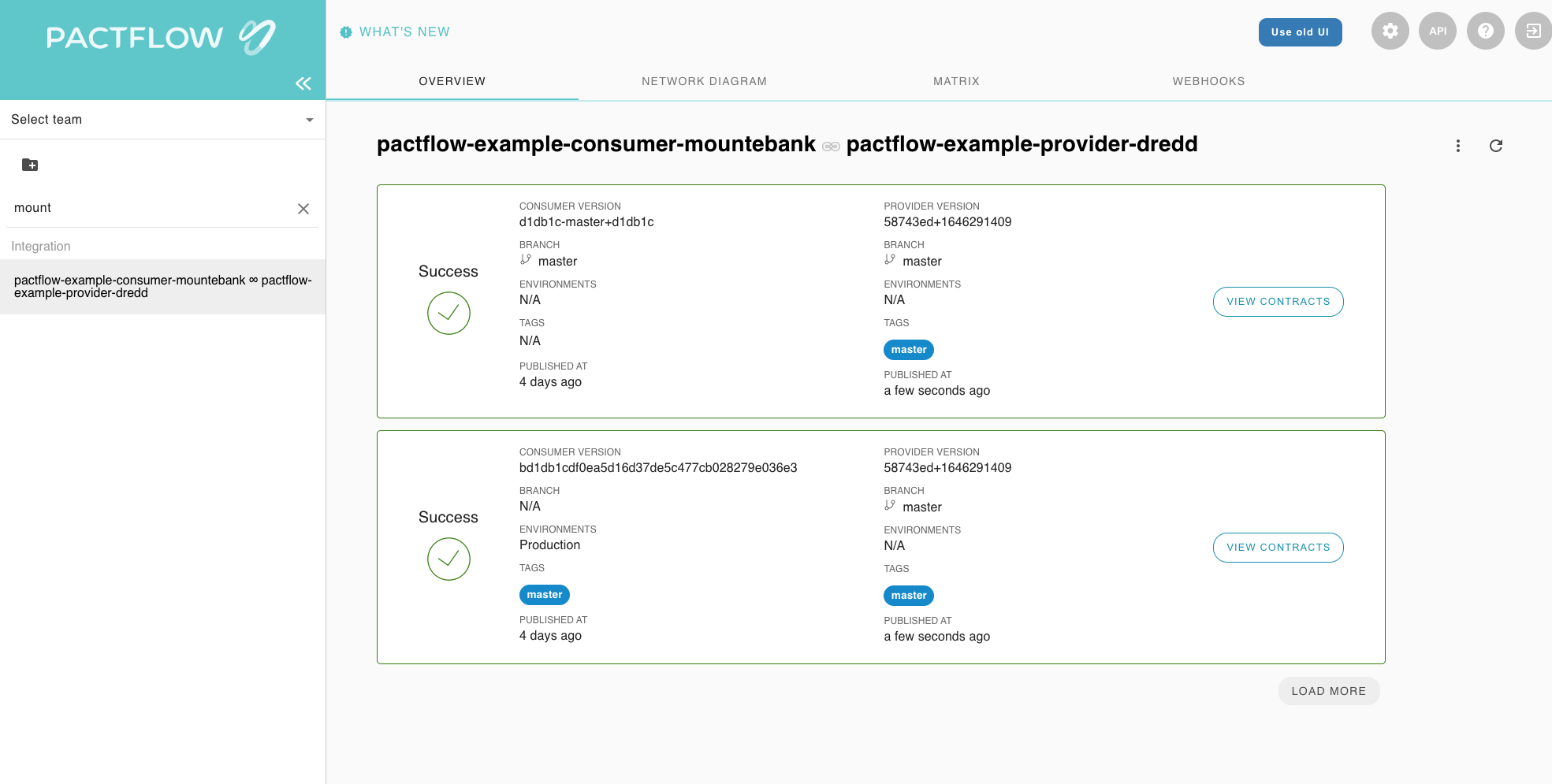9. Deploy your consumer to Production
If you are running in github actions, we will do the publish and deploy step all in one here, as we are running our example from the master/main branch
Now that we have tested our consumer and published our consumer contract, we can deploy the application to production.
Just like our provider counterpart, we're going to call can-i-deploy to check if it's safe before we do.
REMEMBER: The can-i-deploy command is an important part of a CI/CD workflow, adding stage gates to prevent deploying incompatible applications to environments such as production
This diagram shows an illustrative CI/CD pipeline as it relates to our progress to date:

Deploying the consumer build to Production locally
Let's run the command:
npm run can-i-deploy
This should pass, because the provider has already pulbished its contract and deployed to production, and we believe the consumer is compatible with the provider OAS:
$ npx pact-broker can-i-deploy --pacticipant pactflow-example-consumer-mountebank --version $GIT_COMMIT --to-environment production
Computer says yes \o/
CONSUMER | C.VERSION | PROVIDER | P.VERSION | SUCCESS? | RESULT#
-------------------------------------|-----------|---------------------------------|-----------|----------|--------
pactflow-example-consumer-mountebank | 5009e94 | pactflow-example-bi-directional-provider-dredd | 6559541 | true | 1
VERIFICATION RESULTS
--------------------
1. https://test.pactflow.io/hal-browser/browser.html#https://test.pactflow.io/contracts/provider/pactflow-example-bi-directional-provider-dredd/version/6559541/consumer/pactflow-example-consumer-mountebank/pact-version/ce2a9dfed28309e26288b9c9333529c92762d36a/verification-results (success)
All required verification results are published and successful
We can now deploy our consumer to production. Once we have deployed, we let PactFlow know that the new version of the consumer has been promoted to that environment:
npm run deploy
This allows PactFlow to prevent any providers from deploying an incompatible change to production.
Check
Your dashboard should look something like this, where both your consumer and consumer are marked as having been deployed to production:

Deploying the consumer build in Github Actions to Production
Configure consumer pipeline
The source repositories are configured to use the the public broker at test.pactflow.io. You will need to update the credentials to point to your own PactFlow account. To do this, we need to update the PACT_BROKER_BASE_URL environment variable in the Github workflow file, and create a Github Secret to store the PactFlow API token in.
- Create a Github Secret to store your PactFlow API token in.
- In PactFlow:
- Log in to your PactFlow account (
https://<your-subdomain>.pactflow.io), and go to Settings > API Tokens. - Click the Copy button for the read/write CI token (make sure it's the read write one, not the read only one).
- Log in to your PactFlow account (
- In Github:
- Open your forked
example-bi-directional-consumer-<tool>project (https://github.com/<your-username>/example-bi-directional-consumer-<tool>) - Click on the
Settingstab. - Select
Secretsfrom the side menu. - Click
New repository secret(the button is to the right of the "Actions secrets" heading) - Set the name of the secret to
PACTFLOW_TOKEN_FOR_CI_CD_WORKSHOP - Paste in the PactFlow API token value you copied in the previous step.
- Open your forked
- In PactFlow:
- Update your workflow files in GitHub to point at your PactFlow Broker
- In PactFlow:
- Go to Settings > API Tokens.
- Click the
COPY PACTFLOW BASE URLbutton
- In Github:
- Open your forked
example-bi-directional-consumer-<tool>project (https://github.com/<your-username>/example-bi-directional-consumer-<tool>)- Open
.github/workflows/build.yml - In the upper right corner of the file view, click 🖊️ to open the file editor.
- Update the value of
PACT_BROKER_BASE_URLto the base URL of your own PactFlow account. You can easily get this by clicking the COPY PACTFLOW BASE URL button on the API Tokens page in PactFlow. - Press the green
Commit changesbutton
- Open
- Open your forked
- In PactFlow:
- View the build:
- In Github:
- Select the most recent build, this will have been triggered when you committed the changes in the last page
- In Github:
This build should now successfully publish the pact, and it will pass on the can-i-deploy step before it tries to deploy. This is because the provider and consumer has been checked to ensure they are cross-compatible.
Expected state by the end of this step
- The consumer build is passing and it is deployed to production ✅